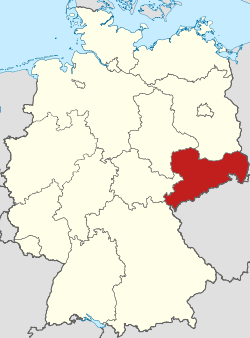Free State of Saxony
| |
|---|---|
| Anthem: Sachsenlied | |
 | |
| Coordinates: 51°1′37″N 13°21′32″E / 51.02694°N 13.35889°E | |
| Country | Germany |
| Capital | Dresden |
| Largest city | Leipzig |
| Government | |
| • Body | Landtag of Saxony |
| • Minister-President | Michael Kretschmer (CDU) |
| • Governing parties | CDU / Greens / SPD |
| • Bundesrat votes | 4 (of 69) |
| • Bundestag seats | 38 (of 736) |
| Area | |
• Total | 18,415.66 km2 (7,110.33 sq mi) |
| Population (31 December 2018) | |
• Total | 4,077,937 |
| • Density | 220/km2 (570/sq mi) |
| Demonym | Saxon |
| GDP | |
| • Total | €146.511 billion (2022) |
| • Per capita | €35,909 (2022) |
| Time zone | UTC+1 (CET) |
| • Summer (DST) | UTC+2 (CEST) |
| ISO 3166 code | DE-SN |
| NUTS Region | DED |
| HDI (2021) | 0.933[2] very high · 8th of 16 |
| Website | www |
Saxony,[a] officially the Free State of Saxony,[b] is a landlocked state of Germany, bordering the states of Brandenburg, Saxony-Anhalt, Thuringia, and Bavaria, as well as the countries of Poland and the Czech Republic. Its capital is Dresden, and its largest city is Leipzig. Saxony is the tenth largest of Germany's sixteen states, with an area of 18,413 square kilometres (7,109 sq mi), and the sixth most populous, with more than 4 million inhabitants.
The term Saxony has been in use for more than a millennium. It was used for the medieval Duchy of Saxony, the Electorate of Saxony of the Holy Roman Empire, the Kingdom of Saxony, and twice for a republic. The first Free State of Saxony was established in 1918 as a constituent state of the Weimar Republic. After World War II, it was under Soviet occupation before it became part of communist East Germany and was abolished by the government in 1952. Following German reunification, the Free State of Saxony was reconstituted with enlarged borders in 1990 and became one of the five new states of the Federal Republic of Germany.
The area of the modern state of Saxony should not be confused with Old Saxony, the area inhabited by Saxons. Old Saxony corresponds roughly to the modern German states of Lower Saxony, Saxony-Anhalt, and the Westphalian portion of North Rhine-Westphalia. Historically the region of Saxony has sometimes been referred to as Upper Saxony or Obersachsen in German to distinguish it from Lower Saxony.
The state is also home to a minority of Sorbs, a West Slavic ethnic group native to the area, numbering an estimated 80,000 people.[3]
- ^ "Bruttoinlandsprodukt, Bruttowertschöpfung | Statistikportal.de". Statistische Ämter des Bundes und der Länder | Gemeinsames Statistikportal (in German). Retrieved 31 July 2023.
- ^ "Sub-national HDI – Area Database". Global Data Lab. Retrieved 13 September 2018.
- ^ Gebel, K. (2002). Language and ethnic national identity in Europe: the importance of Gaelic and Sorbian to the maintenance of associated cultures and ethno cultural identities (PDF). London: Middlesex University. Archived from the original (PDF) on 1 May 2019. Retrieved 13 June 2019.
Cite error: There are <ref group=lower-alpha> tags or {{efn}} templates on this page, but the references will not show without a {{reflist|group=lower-alpha}} template or {{notelist}} template (see the help page).


